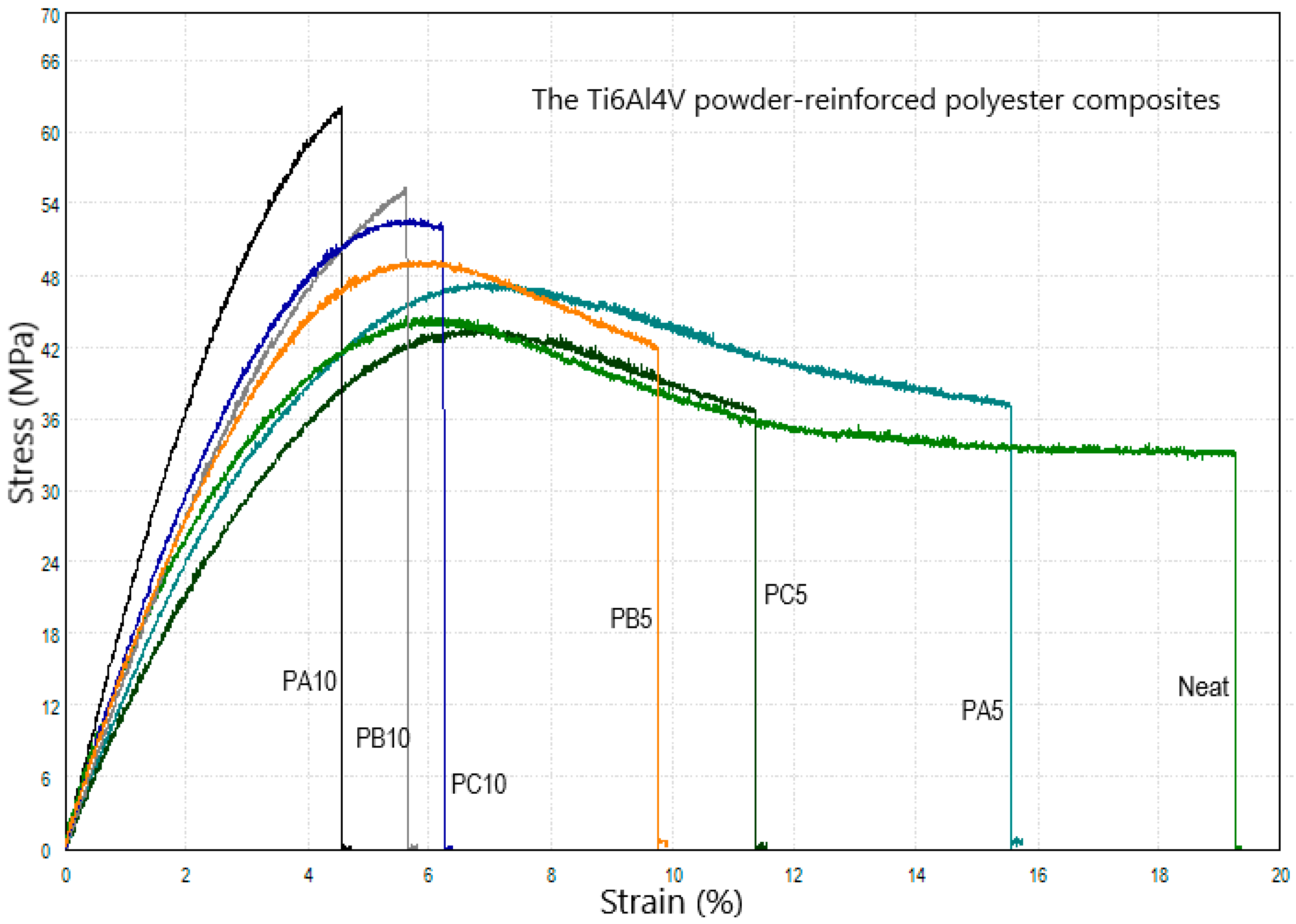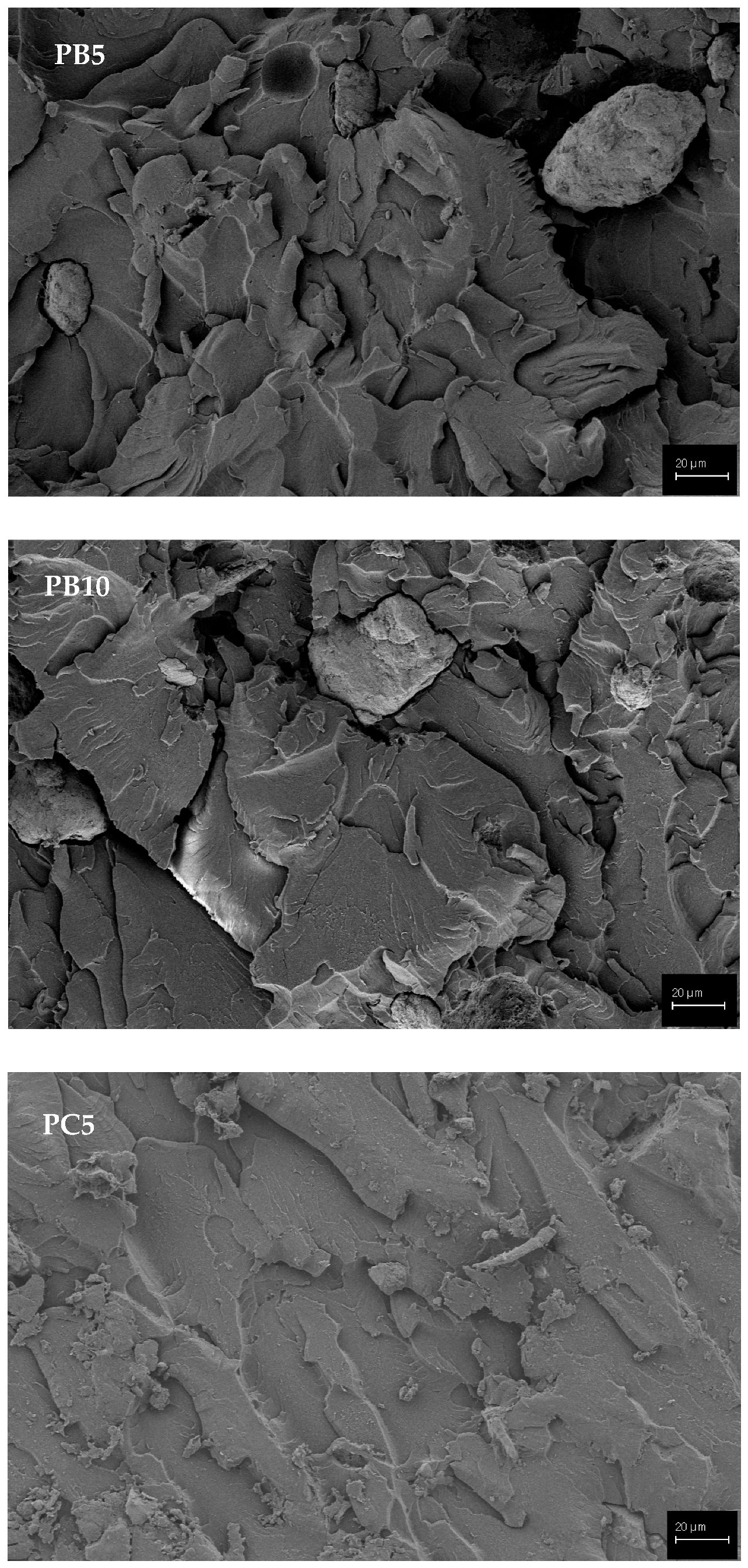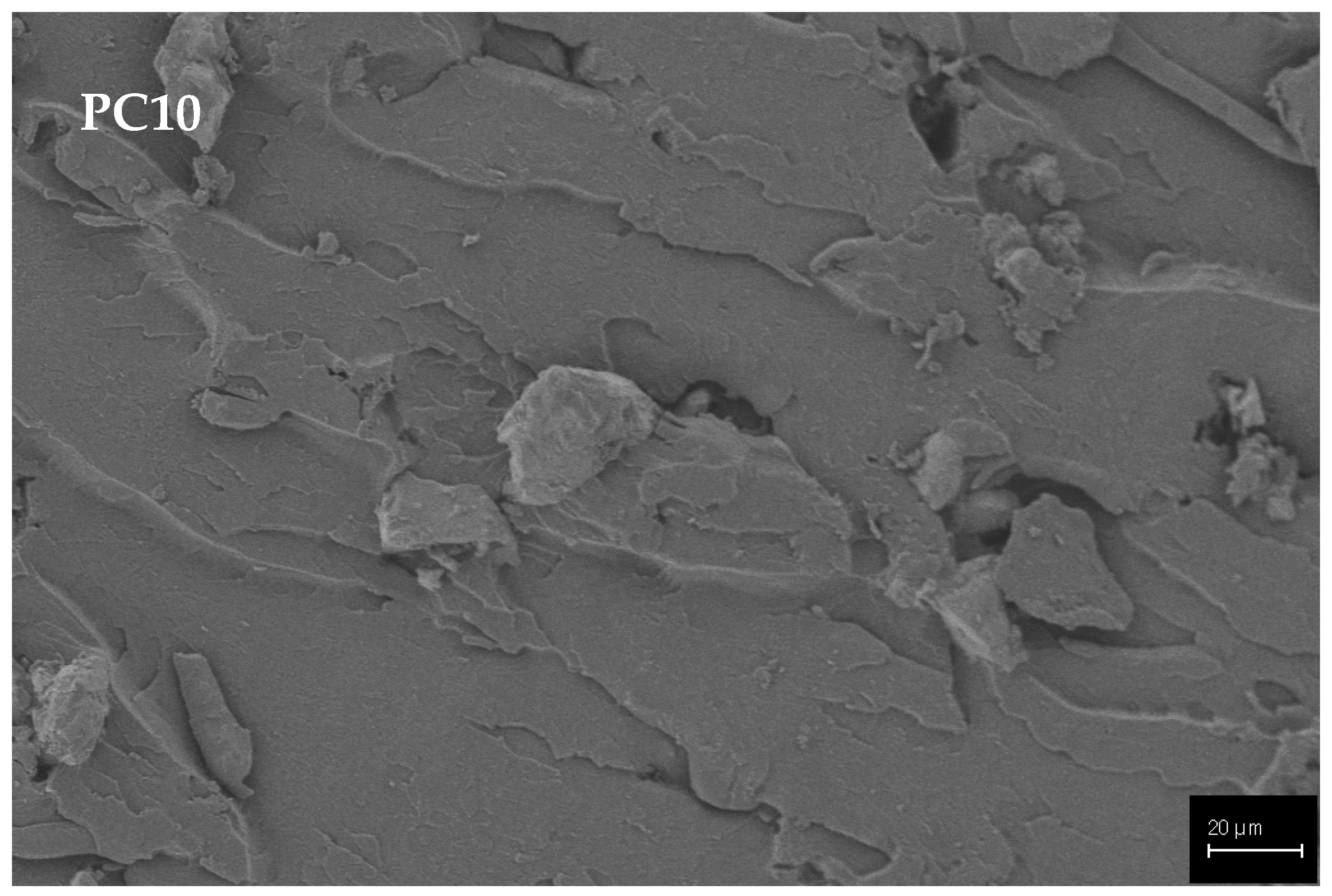The Effect of Various Ti6Al4V Powders on the Behavior of Particle-Reinforced Polyester Matrix Composites
Abstract
:1. Introduction
2. Materials and Methods
2.1. Materials
2.1.1. Preparation of Ti6Al4V Powder
2.1.2. Polymer Matrix
2.2. Experimental Methods
2.2.1. Manufacturing of Composites
2.2.2. Characterization of Composites
3. Results
3.1. Tensile Test Results
3.2. Three-Point Bending Test Results
3.3. Thermal Conductivity Test Results
3.4. Morphology of the Composites
3.5. Effect of Powder Oxygen Concentration on the Mechanical and Thermal Properties of Composites
4. Conclusions
Author Contributions
Funding
Institutional Review Board Statement
Data Availability Statement
Conflicts of Interest
References
- Dvorkin, L.; Konkol, J.; Marchuk, V.; Huts, A. Effectiveness of Polymer Additives in Concrete for 3D Concrete Printing Using Fly Ash. Polymers 2022, 14, 5467. [Google Scholar] [CrossRef]
- Siraj, S.; Al-Marzouqi, A.H.; Iqbal, M.Z.; Ahmed, W. Impact of Micro Silica Filler Particle Size on Mechanical Properties of Polymeric Based Composite Material. Polymers 2022, 14, 4830. [Google Scholar] [CrossRef] [PubMed]
- Zurowski, W.; Zepchlo, J.; Cep, R.; Cepova, L.; Rucki, M.; Krzysiak, Z.; Caban, J.; Samociuk, W. The Effect of Powder and Emulsion Binders on the Tribological Properties of Particulate Filled Glass Fiber Reinforced Polymer Composites. Polymers 2023, 15, 245. [Google Scholar] [CrossRef] [PubMed]
- Nukala, S.G.; Kong, I.; Patel, V.I.; Kakarla, A.B.; Kong, W.; Buddrick, O. Development of Biodegradable Composites Using Polycaprolactone and Bamboo Powder. Polymers 2022, 14, 4169. [Google Scholar] [CrossRef] [PubMed]
- Callister, W.D.; Rethwisch, D.G. Materials Science and Engineering: An Introduction; Wiley: New York, NY, USA, 2018; Volume 9. [Google Scholar]
- Yan, D.-X.; Ren, P.-G.; Pang, H.; Fu, Q.; Yang, M.-B.; Li, Z.-M. Efficient electromagnetic interference shielding of lightweight graphene/polystyrene composite. J. Mater. Chem. 2012, 22, 18772–18774. [Google Scholar] [CrossRef]
- Sahmaran, M.; Li, V.C.; Andrade, C. Corrosion resistance performance of steel-reinforced engineered cementitious composite beams. ACI Mater. J. 2008, 105, 243. [Google Scholar]
- Rajak, D.K.; Pagar, D.D.; Kumar, R.; Pruncu, C.I. Recent progress of reinforcement materials: A comprehensive overview of composite materials. J. Mater. Res. Technol. 2019, 8, 6354–6374. [Google Scholar] [CrossRef]
- Mazuki, A.A.M.; Akil, H.; Safiee, S.; Ishak, Z.A.M.; Abu Bakar, A. Degradation of dynamic mechanical properties of pultruded kenaf fiber reinforced composites after immersion in various solutions. Compos. Part B Eng. 2011, 42, 71–76. [Google Scholar] [CrossRef]
- Velmurugan, G.; Venkatesan, S.P.; Prakash, P.V.; Sathishkumar, N.; Vijayakumar, N. Mechanical testing of hybrid composite material (Sisal and Coir). Int. J. Sci. Res. Publ. 2014, 4, 1–6. [Google Scholar]
- Selvam, R.; Ravi, S.; Raja, R. Fabrication of SiC particulate reinforced polyester matrix composite and investigation. In IOP Conference Series: Materials Science and Engineering; IOP Publishing: Chennai, India, 2017; Volume 197. [Google Scholar]
- Njoku, R.; Okon, A.; Ikpaki, T. Effects of variation of particle size and weight fraction on the tensile strength and modulus of periwinkle shell reinforced polyester composite. Niger. J. Technol. 2011, 30, 87–93. [Google Scholar]
- Teh, P.L. Development Of Core Layer Materials Using Particulate Filled Epoxy Composites [TK7870. 15. T261 2008 f rb]. Ph.D. Thesis, Universiti Sains Malaysia, Pulau Pinang, Malaysia, 2008. [Google Scholar]
- Solberg, D.; Wågberg, L. On the mechanism of GCC filler retention during dewatering-New techniques and initial findings. J. Pulp Pap. Sci. JPPS 2002, 28, 183–188. [Google Scholar]
- Vakharia, V.S.; Kuentz, L.; Salem, A.; Halbig, M.C.; Salem, J.A.; Singh, M. Additive Manufacturing and Characterization of Metal Particulate Reinforced Polylactic Acid (PLA) Polymer Composites. Polymers 2021, 13, 3545. [Google Scholar] [CrossRef]
- Ilyas, R.A.; Sapuan, S.M.; Asyraf, M.R.M.; Dayana, D.A.Z.N.; Amelia, J.J.N.; Rani, M.S.A.; Norrrahim, M.N.F.; Nurazzi, N.M.; Aisyah, H.A.; Sharma, S.; et al. Polymer Composites Filled with Metal Derivatives: A Review of Flame Retardants. Polymers 2021, 13, 1701. [Google Scholar] [CrossRef]
- Yaman, K.; Taga, Ö. Thermal and Electrical Conductivity of Unsaturated Polyester Resin Filled with Copper Filler Composites. Int. J. Polym. Sci. 2018, 2018, 8190190. [Google Scholar] [CrossRef] [Green Version]
- Berger, M.A.; McCullough, R.L. Characterization and analysis of the electrical properties of a metal-filled polymer. Compos. Sci. Technol. 1985, 22, 81–106. [Google Scholar] [CrossRef]
- Alam, A.M.; Beg, M.; Yunus, R. Microstructure and fractography of multiwalled carbon nanotube reinforced unsaturated polyester nanocomposites. Polym. Compos. 2017, 38, E462–E471. [Google Scholar] [CrossRef] [Green Version]
- Krishnasamy, P.; Rajamurugan, G.; Thirumurugan, M. Performance of fiber metal laminate composites embedded with AL and CU wire mesh. J. Ind. Text. 2022, 51, 6884S–6901S. [Google Scholar] [CrossRef]
- Fu, S.-Y.; Lauke, B. Characterization of tensile behaviour of hybrid short glass fibre/calcite particle/ABS composites. Compos. Part A Appl. Sci. Manuf. 1998, 29, 575–583. [Google Scholar] [CrossRef]
- Fu, S.; Lauke, B. Analysis of mechanical properties of injection molded short glass fibre (SGF)/calcite/ABS composites. J. Mater. Sci. Technol. 1997, 13, 389. [Google Scholar]
- Tjong, S.; Xu, S. Ternary polymer composites: PA6, 6/maleated SEBS/glass beads. J. Appl. Polym. Sci. 2001, 81, 3231–3237. [Google Scholar] [CrossRef]
- Lee, C.H.; Khalina, A.; Lee, S.H. Importance of Interfacial Adhesion Condition on Characterization of Plant-Fiber-Reinforced Polymer Composites: A Review. Polymers 2021, 13, 438. [Google Scholar] [CrossRef] [PubMed]
- Peng, X.; Fan, M.; Hartley, J.; Al-Zubaidy, M. Properties of natural fiber composites made by pultrusion process. J. Compos. Mater. 2012, 46, 237–246. [Google Scholar] [CrossRef]
- Jain, K.; Shit, S.; Jain, S. Evaluation of mechanical & thermal properties of polypropylene—Palm kernel nut shell powder composites for green roof technology. J. Inf. Knowl. Res. Mech. Eng. 2013, 2, 456–459. [Google Scholar]
- Singha, A.; Rana, A.K.; Jarial, R. Mechanical, dielectric and thermal properties of Grewia optiva fibers reinforced unsaturated polyester matrix based composites. Mater. Des. 2013, 51, 924–934. [Google Scholar] [CrossRef]
- Uyor, U.O.; Popoola, A.P.I.; Popoola, O.M.; Aigbodion, V.S. Enhanced Thermal and Mechanical Properties of Polymer Reinforced with Slightly Functionalized Graphene Nanoplatelets. J. Test. Evaluation 2019, 47, 2681–2692. [Google Scholar] [CrossRef]
- Nakamura, Y.; Yamaguchi, M.; Okubo, M.; Matsumoto, T. Effects of particle size on mechanical and impact properties of epoxy resin filled with spherical silica. J. Appl. Polym. Sci. 1992, 45, 1281–1289. [Google Scholar] [CrossRef]
- Mamunya, Y.; Davydenko, V.; Pissis, P.; Lebedev, E. Electrical and thermal conductivity of polymers filled with metal powders. Eur. Polym. J. 2002, 38, 1887–1897. [Google Scholar] [CrossRef]
- Shahrezaei, M.A.S.; Goharpey, F.; Foudazi, R. Effect of particle-particle and polymer-particle interactions on nanosilica aggregation in polystyrene. Polym. Compos. 2018, 39, 2904–2914. [Google Scholar] [CrossRef]
- Meng, X.; Huang, Y.; Xie, Y.; Li, J.; Guan, M.; Wan, L.; Dong, Z.; Cao, J. Friction self-riveting welding between polymer matrix composites and metals. Compos. Part A Appl. Sci. Manuf. 2019, 127, 105624. [Google Scholar] [CrossRef]
- Li, Y.; Meng, S.; Gong, Q.; Huang, Y.; Gan, J.; Zhao, M.; Liu, B.; Liu, L.; Zou, G.; Zhuang, D. Experimental and Theoretical Investigation of Laser Pretreatment on Strengthening the Heterojunction between Carbon Fiber-Reinforced Plastic and Aluminum Alloy. ACS Appl. Mater. Interfaces 2019, 11, 22005–22014. [Google Scholar] [CrossRef]
- Rumble, J. CRC Handbook of Chemistry and Physics; CRC Press: Boca Raton, FL, USA, 2017. [Google Scholar]
- BBalandin, A.A. Thermal properties of graphene and nanostructured carbon materials. Nat. Mater. 2011, 10, 569–581. [Google Scholar] [CrossRef] [Green Version]
- Sonvane, Y.; Gupta, S.K.; Raval, P.; Lukačević, I.; Thakor, P.B. Length, width and roughness dependent thermal conductivity of graphene nanoribbons. Chem. Phys. Lett. 2015, 634, 16–19. [Google Scholar] [CrossRef]











| Powder | d(10) μm | d(50) μm | d(90) μm | Oxygen (ppm) |
|---|---|---|---|---|
| A | 4.4 | 15.4 | 35.7 | 34,840 |
| B | 14.4 | 34.6 | 60.7 | 20,966 |
| C (Commercial) | - | 15–45 | - | 2565 |
| Appearance | Transparent |
|---|---|
| Color | Clear |
| Density | 1.11 g/cm³ |
| Flash point | 32 °C |
| MEK-P hardener | % 1 |
| Usable life | 30 min/25 °C |
| Cure time | 12 h/25 °C |
| Sample Code | Polyester (wt.%) | Ti6Al4V Powder (wt.%) | Powder Type |
|---|---|---|---|
| Neat | 100 | 0 | - |
| PA5 | 95 | 5 | Recycled |
| PA10 | 90 | 10 | Recycled |
| PB5 | 95 | 5 | Recycled |
| PB10 | 90 | 10 | Recycled |
| PC5 | 95 | 5 | Commercial |
| PC10 | 90 | 10 | Commercial |
| Sample | Tensile Strength (MPa) | Young’s Modulus (GPa) |
|---|---|---|
| Neat | 44.83 ± 2.46 | 1.21 ± 0.03 |
| PA5 | 47.42 ± 4.20 | 1.17 ± 0.13 |
| PA10 | 62.17 ± 3.16 | 1.92 ± 0.10 |
| PB5 | 49.35 ± 4.02 | 1.35 ± 0.13 |
| PB10 | 55.38 ± 3.34 | 1.39 ± 0.09 |
| PC5 | 43.58 ± 2.22 | 0.99 ± 0.08 |
| PC10 | 52.67 ± 2.71 | 1.48 ± 0.05 |
| Sample | Flexural Strength (MPa) | Flexural Modulus (MPa) |
|---|---|---|
| Neat | 106.61 ± 2.44 | 2.280 ± 0.05 |
| PA5 | 103.92 ± 4.58 | 2.525 ± 0.11 |
| PA10 | 118.33 ± 3.71 | 2.945 ± 0.09 |
| PB5 | 101.78 ± 4.40 | 1.973 ± 0.10 |
| PB10 | 135.85 ± 3.03 | 3.098 ± 0.08 |
| PC5 | 93.54 ± 3.82 | 1.956 ± 0.08 |
| PC10 | 104.09 ± 2.87 | 2.774 ± 0.06 |
| Sample | Thermal Conductivity (W/mK) |
|---|---|
| Neat | 0.2502 ± 0.001 |
| PA5 | 0.2271 ± 0.003 |
| PA10 | 0.2317 ± 0.003 |
| PB5 | 0.2121 ± 0.001 |
| PB10 | 0.2344 ± 0.003 |
| PC5 | 0.6079 ± 0.020 |
| PC10 | 0.6319 ± 0.010 |
Disclaimer/Publisher’s Note: The statements, opinions and data contained in all publications are solely those of the individual author(s) and contributor(s) and not of MDPI and/or the editor(s). MDPI and/or the editor(s) disclaim responsibility for any injury to people or property resulting from any ideas, methods, instructions or products referred to in the content. |
© 2023 by the authors. Licensee MDPI, Basel, Switzerland. This article is an open access article distributed under the terms and conditions of the Creative Commons Attribution (CC BY) license (https://creativecommons.org/licenses/by/4.0/).
Share and Cite
Teke, E.; Seydibeyoğlu, E.A.; Seydibeyoğlu, M.Ö. The Effect of Various Ti6Al4V Powders on the Behavior of Particle-Reinforced Polyester Matrix Composites. Polymers 2023, 15, 2904. https://doi.org/10.3390/polym15132904
Teke E, Seydibeyoğlu EA, Seydibeyoğlu MÖ. The Effect of Various Ti6Al4V Powders on the Behavior of Particle-Reinforced Polyester Matrix Composites. Polymers. 2023; 15(13):2904. https://doi.org/10.3390/polym15132904
Chicago/Turabian StyleTeke, Erdoğan, Elif Alyamaç Seydibeyoğlu, and Mehmet Özgür Seydibeyoğlu. 2023. "The Effect of Various Ti6Al4V Powders on the Behavior of Particle-Reinforced Polyester Matrix Composites" Polymers 15, no. 13: 2904. https://doi.org/10.3390/polym15132904






